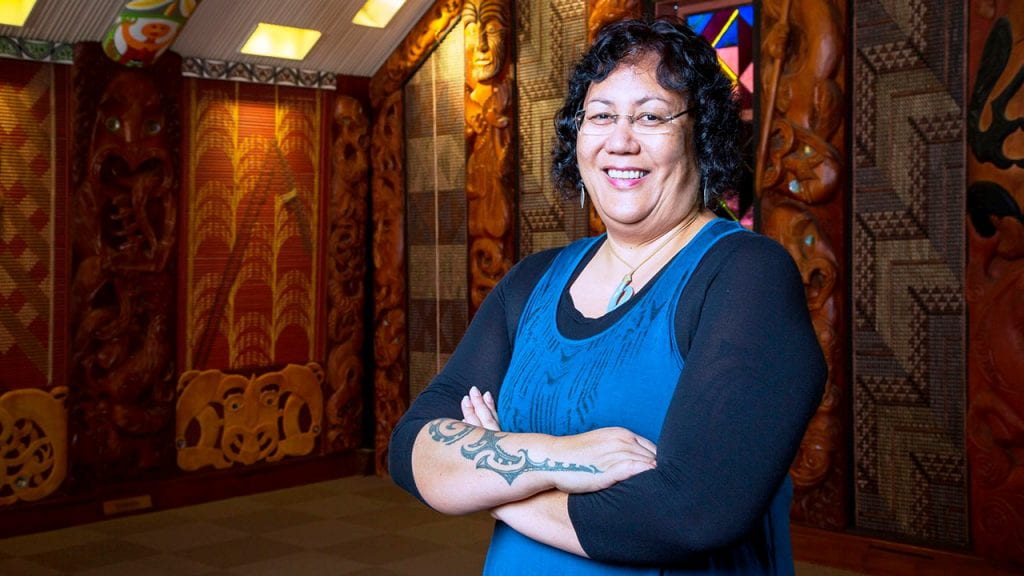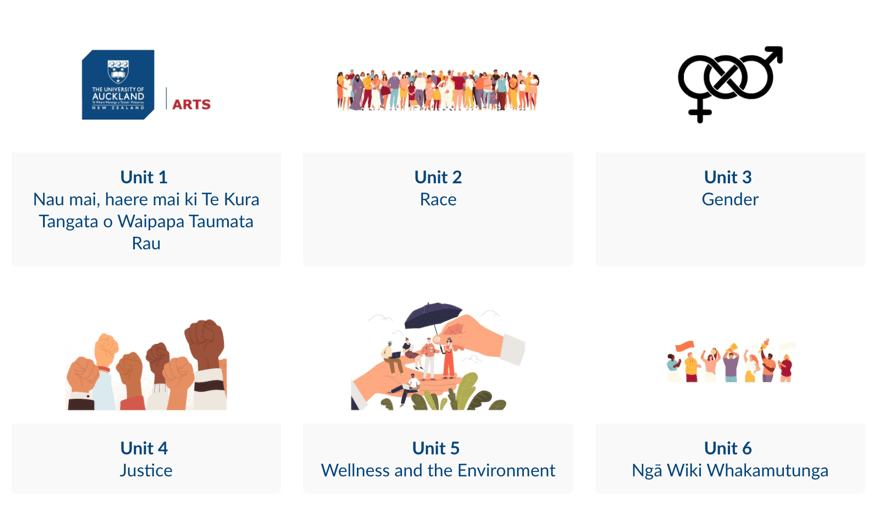Ko wai tātou? Who are we?
Aroha Harris, alongside her teaching team co-designed a first-year, first semester, compulsory Arts general course for all Faculty of Arts students—this was a pilot course “Ko wai tātou? Who are we?”

The vision for this course was to build a cohort community through whanaungatanga, and to introduce students to university academic skills that would lay the foundation for the rest of their studies at Waipapa Taumata Rau.
Whanaungatanga is to encourage the development of close connection between people, to create a sense of belonging.1
The mantra, “What is the whanaungatanga response?” became the key question the design team asked themselves every time they hit a roadblock, whether that was scaffolding of teaching and learning, assessment design, or whose voice was needed in design meetings. This idea of “connection” whether it be peer-peer, student-teacher, or student-subject and Arts context, or connection to oneself (through self-reflection) was the considered approach to both design and facilitation elements of this course.
Scaffolding of teaching and learning
All elements of the final group project were designed to be scaffolded throughout the entire course through, skills development, and reflection of the process of group dynamics. Getting to know you activities were built in as low stakes (1%) assessments that students could complete during workshop times, i.e., data analysis (survey of cohort) and performance (“I am” poem). This design helped to build relational learning by connecting students to each other, as well as the teacher. It also helped give them a connection to potential outputs used across a range of Arts subjects so they could explore the area that interested them the most for the final project. This connection to the context of subjects in Arts is an important part of relational learning, so that students can be exposed to potential career and study pathways.
Assessment design
The first assessment in this course is a personal reflection answering, “What are you studying in Arts and why?” The purpose of this reflection was to identify what they were interested in studying in Arts, to find their personal voice in academic writing, and to practise academic writing under a tight deadline. This assessment was marked using audio feedback. This further developed relationality between the teacher and the student, as the student was able to hear the tone and intention of the marker’s feedback. A nice side effect of this was that students decided to use the audio feedback feature to submit their process reflections, later in the course. (Connection student to teacher. Connection student to self. Connection student to context.)
The second assessment is a group assessment focused on the academic skillset of citation and referencing. As group assessments are an integral part of further study in the Faculty of Arts, it was important to develop this skill of collaborating and co-constructing early. (Connection student to peers.)
For every assessment, the purpose and audience was made explicit so that students could understand the why behind the task. (Connection student to context.) Due to the vision of this course being about building community (whanaungatanga) and developing academic skills, often both these elements were baked into the assessment design (see the example).
Annotated bibliography 10%
Purpose
Finding, selecting and recording reliable sources is a key aspect of writing in an academic way. It honours the whakapapa of the published knowledge in your Arts subject and the people who have gone before you. It also recognises your place within the continuing conversation.
This assessment is designed to help you:
- Find and select reliable and relevant sources in your selected Arts subject.
- Practice accurately recording your sources in the Chicago reference style.
- Collaborate with your group to co-construct a bibliography.
- Explain how and why you selected a particular source.
Audience
Your final co-constructed bibliography may be shared with your wider cohort and can be used to inform your next essay assignment.
Instructions for setting up groups
You will be working in groups of 2-3 for this assignment. You can choose your own groups by going to People on the left side menu and clicking on the groups tab. From there you and your group must self-select one of the annotated bibliography groups to be part of.
Teaching team
As this is a general Arts paper, there are many different subject areas to cover to give students a sampling of future study paths. Aroha framed the learning through the themed conceptual lenses, e.g., Race, Gender, Justice etc. There was a unit module leader assigned to each. Each lecturer then set the overall tone for the module, and guest lecturers attended lectures in a TED Talk panel-type manner, and each spoke to their area of expertise. These panel discussions were highlighted as being a favourite amongst staff, and students. (Connection student to subject. Connection student to teacher. Connection teacher to their peers.)
To teach on this course lecturers put in an Expression of Interest; from there the Unit leaders were selected and the collaborative teaching teams were formed. A development team from Ranga Auaha Ako | Learning and Teaching Design Team (RAA) worked closely with the module leaders to frame the learning, and to keep the assessment framework top of mind. Weekly meetings were held with RAA, Unit leaders, course coordinators, teaching team members, and the Tutorial Assistant, which allowed for iterative changes as the course commenced. This level of collegiality flowed through the teaching practices of the team and created a vibrant community of collaboration for the students to experience in class (Connection teacher to peer. Connection teacher to student.)
Aroha also invited her Professional Teaching Fellow (PTF) into the design conversations. This helped the development of the course immensely as the PTF was responsible for weaving the tutorials into the lecture content, and scaffolding into the assessment work. This also allowed the RAA learning designers to have reflective conversations with the PTF to evaluate whether the assessments were working as designed and fit for purpose. (Connection PTF to rest of teaching team). This impacted relational learning for students, as they were able to participate in a holistic learning experience, rather than piecemeal learning with different lecturers adding their own unique flair.

Course vision realised?
A smaller cohort of students (less than 15), meant that the mechanics of the group work and assessment were not able to be rigorously tested for scalability. However, for those students that did collaborate with their group, there was a noticeable difference in their confidence in the delivery of the final project, spoken word poem, and a podcast. The vision for creating community through whanaungatanga was realised in these smaller groups. For the next iteration, more attention is planned to give focus to building successful group dynamics, and how to take personal responsibility for dealing with conflict and miscommunication. (Connection student to group).
- Matiu Tai Rātima, Jennifer Pearl Smith, Angus Hikairo Macfarlane, Nathan Mahikai Riki, Kay-Lee Jones, Lisa Kaye Davies (Eds.) (2022). Ngā hau e whā o Tāwhirimātea: Culturally responsive teaching and learning for the tertiary sector. University of Canterbury Press. ↩

